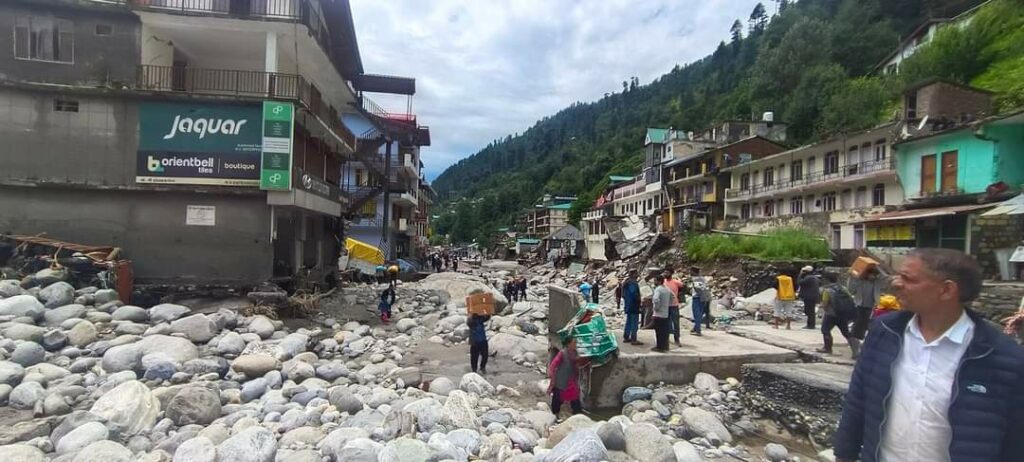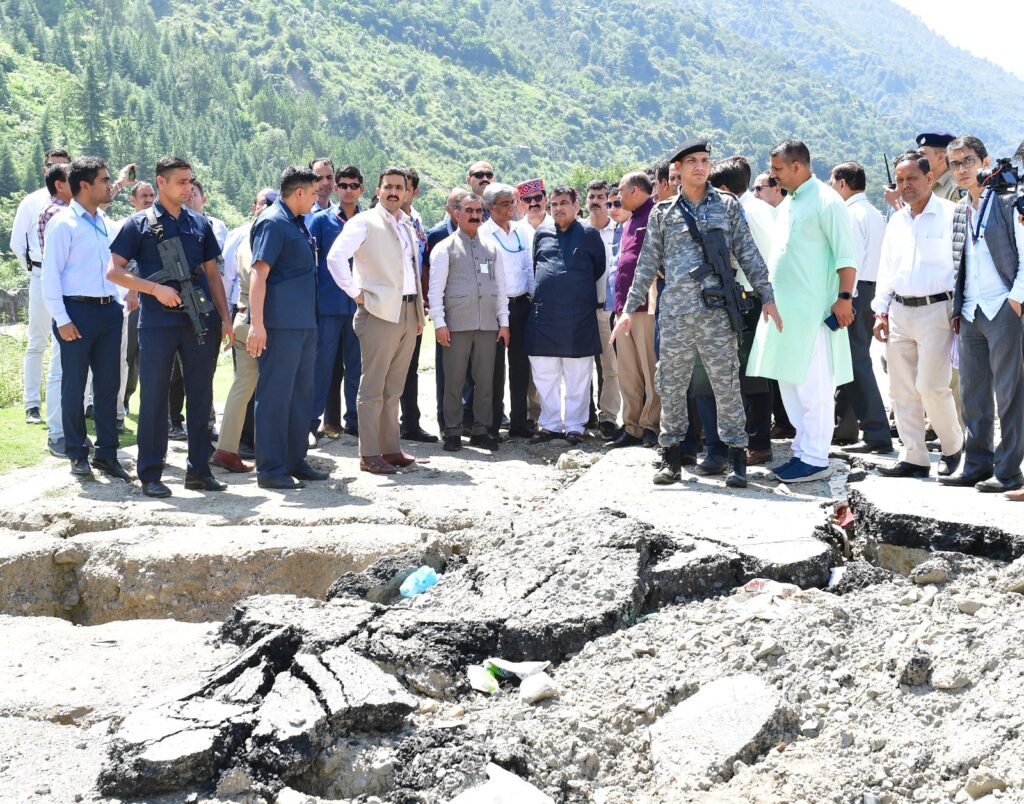Manali: A spate of national highways bending along the Himalayan rivers have cropped up in Himachal Pradesh over the past years. Several of these roads, built by the National Highways Authority of India by cutting up mountains, are deemed “all-weather” but the recent floods have exposed a different reality. However river didn’t come to us, we went to it.

The floods that ravaged the state in July this year left over 130 dead, thousands displaced, and more than 1,200 roads blocked due to landslides, erosion, and damage. In Kullu district alone, around 170 roads were blocked. The traffic on one of the most high-profile and newly-built highways in Himachal, the Kiratpur-Mandi-Kullu-Manali Highway also came to a standstill as the roadway witnessed heavy damages, raising questions over the quality of roads and the use of a scientific approach in its construction.
Vinod Kumar, the driver of one of the thousand vehicles stranded on the highway, told hill post that he comes here twice each month this season (with tourists). The new highway was opened to the public only a few days ago, but it had to be closed off due to rain. He had never thought that this highway built over so many years would collapse in one monsoon itself”
Locals told hillpost that private companies have been dumping construction waste in the rivers which have contributed to the floods. Meanwhile, experts say that rapid and unscientific road construction in the hills was also a major cause of the flood.
The 197 km long Kiratpur-Manali Highway is arguably one of the biggest road construction projects in Himachal Pradesh, expected to be built at a cost of around Rs 18,000 crore. Its inauguration was pushed back when a 16-km stretch of it was damaged during the floods in July. It will take months before it’s opened now for use.
The highway is part of a series of construction in the state to reduce the travel distance between Chandigarh and Manali. At least 37 bridges and 14 tunnels are also being constructed on the highway for this purpose.
On a visit to the flood-affected areas on August 1, Union Minister of Road Transport and Highways Nitin Gadkari said the stones and gravel in the region are “fragile” and instantly break and flow into the river during heavy rains, raising the bed level of the river and infuriating the floods. “There are only a few places on these mountains where there are solid rocks. Most places have stones, gravel, and soil.”

Highways being constructed in the Himalayan region, branded as all-weather roads, are eroded by the rains each year. Gadkari said the flow of rivers in hilly regions also results in broken roads.
However, according to experts, the broken roads were a result of unscientific construction, and not the mountain or rivers.
According to a geologist, the construction of roads in Himachal Pradesh was not being done under the guidance of experts, but through arbitrary cutting down of mountains. They add that in places where roads are being widened, only workers and JCB operators are working.
There were drawbacks to cutting into mountains for building roads. Not just in Kullu but wherever our road construction work has been undertaken in Himachal Pradesh, they have many experiences and lessons to draw from. It is seen that wherever mountains have been cut down very steeply, the slopes have not stabilized even after 4-5 years of construction. This results in roads breaking frequently, so they are blocked again and again. It also causes the loss of public and private property.”
The slopes are left to natural forces after construction but when the mountains are cut up, it takes many years for the slopes to stabilize. To prevent mountains from slipping along the side of the road, the angle for cutting the mountain cannot be above a certain limit. This angle is called the angle of repose.
Although 45- or 40-degree slopes are considered stable. But if we cut them up vertically at 90 degrees, then in geological terms it is said that we have changed the angle of repose of the slope. Wherever we change this angle, the probability of landslides increases by manifolds.”
Even a month after the floods in the Himalayan state, the roads remain closed in over 300 places where frequent landslides are being reported.
Thousands of tons of debris from highway construction were dumped into the river which became a major cause of the floods this year. Referring to a court order, the Himachal Pradesh High Court had directed state officials to ensure that debris is not dumped into the Govind Sagar Dam and its feeding drains.
Congress leader and social activist Vidya Negi, who has been living in Manali for several decades, also said the encroachment upon rivers and unscientific construction majorly contributed to the floods. “The river had not come to us, but we have gone closer to the river and this is why we saw such losses.”
Manali had reported heavy destruction in this year’s floods, with thousands of people being stranded in the hill town.
Negi alleged hastiness and corruption in highway construction. “What is the quality of the work done on four-lane and two-lane roads? Keeping this region in mind, there was a provision for extra-budgetary allocation, but I don’t think the money was spent that way.”
She said the government built the sand and brick walls along the river, without using rods or cement, and as soon as the river’s flow rose, the sand went into the river.
After his Himachal visit, union minister Nitin Gadkari suggested “straightening the course of the river” to prevent floods and the consequent destruction. “Roads have been constructed next to the river. The bed level of the river is rising which causes flooding…We have tried to find a solution for this,” he said at a press conference in Nagger near Kullu district on August 1, adding that the “government is weighing some long-term solutions”.
Gadkari said, “After a technical committee presents its report, we will dig it (the river) for 2-3 meters and use the stones and sand taken out to build such a strong wall of stone and concrete on both sides of the river that the water won’t go anywhere.”
However, experts have raised questions about the union minister’s suggestion.
However the geologist says that to protect oneself from “the rage of the great Himalayan rivers like Ganga, Beas or Satluj, one must let them flow in their natural course”. They say that it is not a scientific solution and stopping the flow of large and long rivers for such solutions could cost hundreds of crores.
“A concrete or RCC wall cannot control the flow of these rivers. We must understand that these rivers are not coming into our homes. We have stopped the course of the rivers by constructing or encroaching upon them. In the days to come, extreme weather phenomena will result in the water rising suddenly in the rivers and then such solutions will prove futile.”
A resident Arun Kumar alleged that if the NHAI had paid a little more attention to the quality of work while constructing the road, then the loss may have been less. He said that the NHAI should take lessons from the Himachal government as old crate walls along the river not only prevented damage to the roads but saved many lives, houses, and properties from being washed away.
Another resident Vinay said that the RCC wall being constructed by the state government at the Volvo bus stand in Manali did not let the river divert its course and protected many properties. The NHAI should construct such strong flood protection walls in flood-prone areas.
Another resident Ajay alleged that the NHAI had dumped muck along the water bodies in many areas which caused more devastation. He further alleged that the quality of the retaining walls to provide protection from the landslides was poor and many portions along the Bhuntar-Manali national highway were witnessing frequent landslides.
Meanwhile, the residents said that quality checks of the road should be done at various points and if any negligence was found on the part of the contractors of the NHAI, they should be dealt with strictly by imposing a penalty for the losses.

Sanjay Dutta, an engineer by qualification but is a journalist by choice.
He has worked for the premier new agency Press Trust of India and leading English daily Indian Express.
With more than a decade of experience, he has been highlighting issues related to environment, tourism and other aspects affecting mountain ecology.
Sanjay Dutta lives in a village close to Manali in Kullu valley of Himachal.


Excellent article by Sanjay, well analysed and articulated these are the sad ground realities. Wonder if someone is really listening to these realities, need to paise and think as to what we are leaving for our next generation.
Keep up the good work of highlighting the environmental issues Sanjay and hope like hell that someone in the hierarchy who can take some hard decisions is listening , till then all the best.